Mi., Nov. 30th 2022
Candlelit windows, fairytale markets, and centuries-old traditions make the holiday season in Switzerland truly magical. Here’s a helpful guide to the most common Swiss holiday traditions, their history, and how to celebrate them at home.

At Basel’s Christmas market you may find a giant Christmas pyramid, or Weihnachtspyramide.
Christchindlimärt
Swiss Christmas markets, or Christchindlimärt, are famous worldwide and well-loved by tourists and locals alike. They are the perfect place to indulge in all things Christmas. There’s a certain magic in drinking spiced mulled wine (Glühwein) while you wander through rustic wooden chalets covered in twinkling lights. You can check off your Christmas list off with handmade gifts from local artisans or enjoy a traditional food like Raclette, heisse Maroni, or Magenbrot.
Many villages have a Christchindlimärt for a week in early December. Bigger cities like Bern, Geneva, and Zurich have markets that start at the end of November and finish around December 24th. The Basel Christmas market is often considered the prettiest in Europe. Please keep in mind that if you buy Glühwein in a mug, you’ll be expected to put down a deposit until you return the mug for someone else to use.
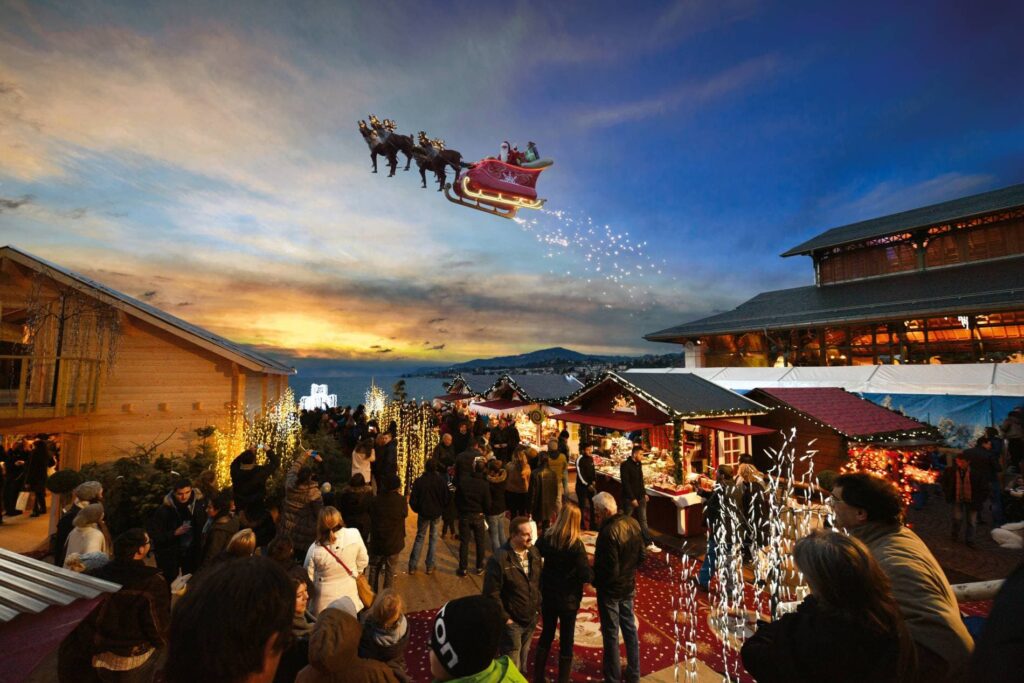
At Montreux’s lakeside Christmas market, a model of Père Noël (Santa Claus) flies over every evening.
Some of the best Christmas markets of 2022:
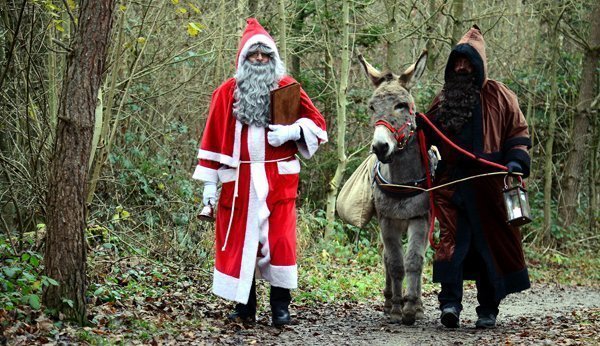
A Swiss Santa Claus, or Samichlaus, is a thin man who lives in the forest (Image: Landbote / Marc Dahinden).
Samichlaus and his sidekick Schmutzli
Swiss Samichlaus, or Saint Nicolas in French, arrives on December 6th. Like the Coca-Cola Santa Claus, he wears red and white, but that’s where the similarities end. Samichlaus is a thin man who is dressed as a bishop, not a jolly man whose belly shakes like a bowl full of jelly! He doesn’t come down the chimney or have a sleigh pulled by reindeer. Instead, Samichlaus emerges from the forest with a big bag of treats, a donkey, and his semi-scary sidekick Schmutzli.
Schmutzli (from Schmutz or dirt), called Père Fouettard in French, dresses all in black with a dirt-covered face and stands quietly beside Santa. His intimidating presence is supposed to be a deterrent to bad behavior. The tradition is based on the patron saint of children, St. Nicholas of Myrna, a Bishop from the fourth century who passed away on December 6th. Schmutzli is believed to be based on Perchtenlaufen — festivals to drive out demons held in many alpine countries.
Traditionally, Samichlaus und Schmutzli knock on children’s doors in the evening. Samichlaus reads from a book where he keeps a checklist of children’s good and bad behavior. After a gentle reminder to be kind, children recite a Christmas poem or Samichlaus-Versli. Well-behaved children are rewarded with a Samichlaus Säckli, a burlap bag filled with nuts, mandarins, chocolate, and cookies.
Many Swiss villages have Samichlaus processions in the evening, where you can meet Samichlaus und Schmuzli. In some villages, you can take a short hike to a small hut, or Waldhüsli, where you can visit Samichlaus in his natural habitat.
To celebrate at home, you can purchase premade Samichlaussäckli made at your local Swiss grocery store or you can make your own. Some traditions say to place the treats in people’s shoes. For more details about how to celebrate with kids, check out this article.
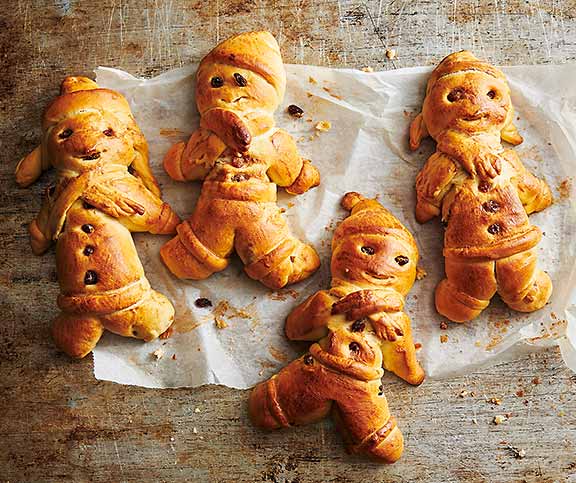
Grittibänz are men made of sweet dough — often made and eaten on St. Nicholas Day, December 6th (Credit: Betty Bossi).
Grittibänz
Grittibänz is a sweet bread shaped like St. Nicholas. Grittibänz is closely tied to December 6th and usually appears in stores at the beginning of December. The sweetened bread is made from traditional Zopf dough shaped into a small person and decorated with raisins and pearl sugar, called Hagelzucker. Sometimes they have a pipe, hat, scarf, bundle of sticks, and sometimes a delicious chocolate bar or Schoggistängeli.
Grittibänz are said to date back to the 16th century, but worshiping Saint Nicholas, who Grittibänz is said to look like, began in the 11th century. What Grittibänz means is subject to some discussion. The Idiotikon, the Swiss-German dictionary, states that the term Gritti means a “frail old man who walks with his legs apart,” while Bänz is short for Benedict.
Sometimes Samichlaus brings the Grittibänz to children at school or as part of their Samichlaus Sackli. Some families and friends bake Grittibänz together and eat them for dinner on December 6th, St. Nicholas day. If you live outside of Switzerland, you can still make your own Grittibänz with this easy-to-follow recipe.
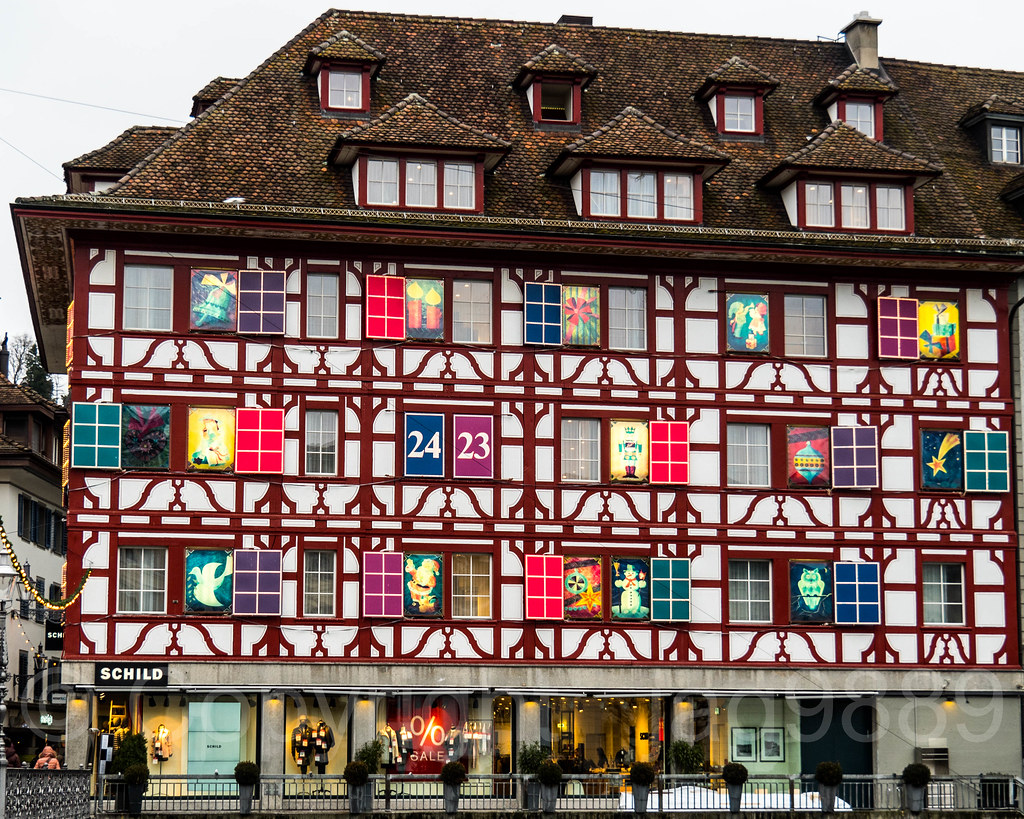
A department store in Lucerne decorated as an advent calendar (Credit: Schild AG).
Adventsfenster und Adventskranz
Like in many parts of Europe, Swiss people enjoy the tradition of counting down the days to Christmas eve. Advent calendars count 24 days from December 1st to 24th. The word Advent is derived from the Latin word for coming. Advent calendars can be traced back to the 19th century when families would mark every day in December until Christmas Eve with a chalk line.
Beginning in late November and early December, you’ll start to see around Switzerland festively decorated windows known as Adventsfenster. These windows are like a communal living advent calendar intended to bring holiday cheer during the dark winter evenings.
Typically, 24 homes and local businesses will work together to create the Adventsfenster. Each person is assigned one of the 24 days of advent, then, day by day at a set time, decorated windows are revealed from behind the shutters. Sometimes, the window presentation is paired with Christmas carols and an invitation to share some Glühwein and gingerbread.
You can still participate even if you’re not part of a group. Just decorate your window, front door balcony, or garden. The goal is to make sure your decorations are visible at night. Tissue paper illuminated by lights or dark paper cutouts is an easy place to start.
Try contacting the local tourism office in your village or asking at the town hall if anyone is organizing an Adventsfenster. You can also take the initiative to bring joy to your community by organizing an Adventsfester in your town or apartment building.
Adventkranz, or advent wreaths count the four Sundays before Christmas. Wreaths are either styrofoam rings or pieces of wood decorated with winter foliage and four candles. Each Sunday, a candle is lit until the final candle is lit on the 24th. You can make your own Adventskranz and decorate it with items collected in the forest. To add some color, head to your local Brockenhaus for inexpensive Christmas baubles.
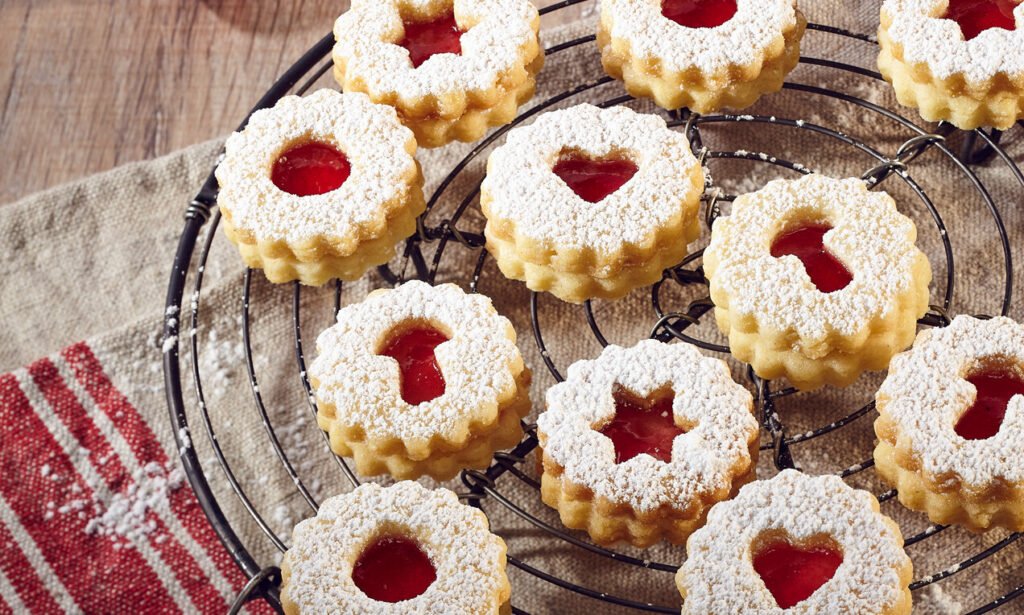
Jam-filled spitzbuben are a traditional Christmastime cookie in Switzerland.
Weihnachtsguetzli
There’s nothing quite like the smell of Christmas cookies baking to cheer your heart, and Weihnachtsguetzli are a special part of a Swiss Christmas.
Many families share recipes that have been passed down for generations. Some of the most popular cookies include Zimtsterne (cinnamon stars), Anisbrötli or Chräbeli (anis rolls), Vanillegipfeli (vanilla crescents), and Brunsli (spiced chocolate).
Mailänderli are the perhaps the most traditional of Swiss Christmas cookies. The recipe dates back at least 300 years: flour, sugar, and butter in a ratio of 2:1:1. They are glazed with powdered sugar and lemon juice. Spitzbuben, meaning mischievous boy, is another favorite. They’re decorative jam-filled sandwich cookies that date back to the 20th century.
It’s believed that monasteries made elaborate baked goods during the middle ages to celebrate Christ’s birth and then distributed them to the poor. Other theories date to the ancient celebration of the winter solstice when small treats were made as sacrifices to evil spirits said to haunt homes on December 21st.
There are plenty of websites with recipes in English, but if you can find a Swiss person to make Weihnachtsguetzli with, it’s even better! Put your cookies in a festive tin and bring them to work or deliver them to neighbors.
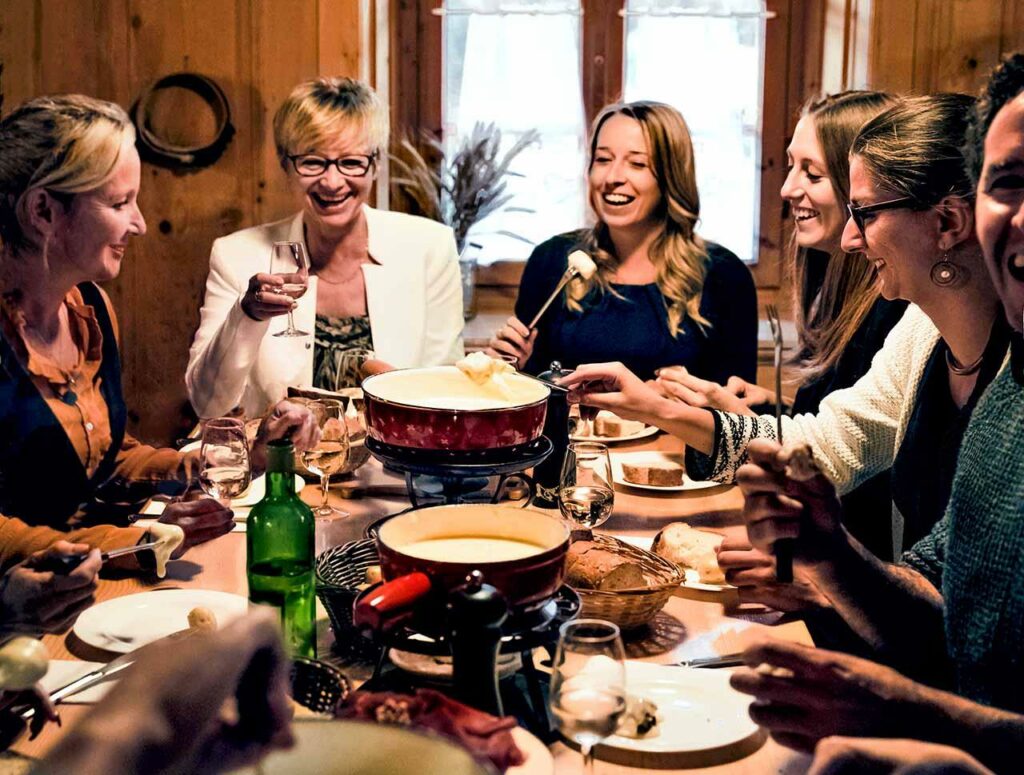
A classic Swiss Christmas Eve includes cheese fondue and family (Credit: Fribourg Region).
Heiliger Abend
In Switzerland, December 24th is called Heiliger Abend, which translates to holy night.
Heiliger Abend is when many Swiss families celebrate Christmas together. The day is spent decorating the Weihnachtsbaum, or Christmas tree, getting the presents ready to place under the tree, and preparing the meal. Families often eat cheese fondue or fondue Chinoise in the early evening and then spend the rest of the night around the tree: singing carols and eating Christmas cookies. Some families attend a candlelight mass at 11 p.m. Meanwhile on Christmas Day, the 25th, many families are finished celebrating and enjoy the start of the winter sports season by heading outdoors.
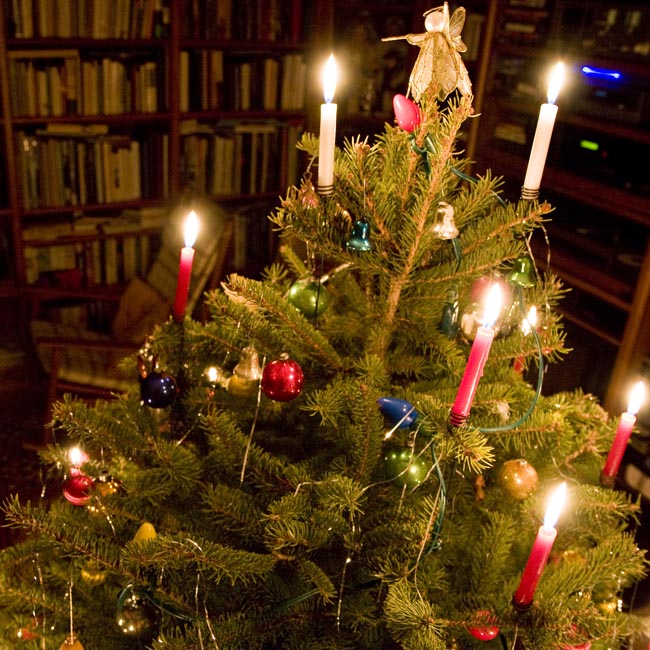
A traditional Swiss Christmas tree does not go up until Christmas Eve and it is lit with real candles (Credit: Rick Steves).
Christkindli
Traditionally, the tree and gifts stay hidden until the evening of December 24th. Children are told that the Christchild, Christchindli, delivered the presents. Christchindli is an angelic child, usually depicted with blond hair and wings.
Die Christkindl figure, as a gift giver, was first introduced by Martin Luther during the Protestant Reformation in the 16th century. The reformation’s doctrine stated that praying to Saints was idol worship, so the Christkindli, meant to evoke the idea of Christ, replaced St. Nicholas.
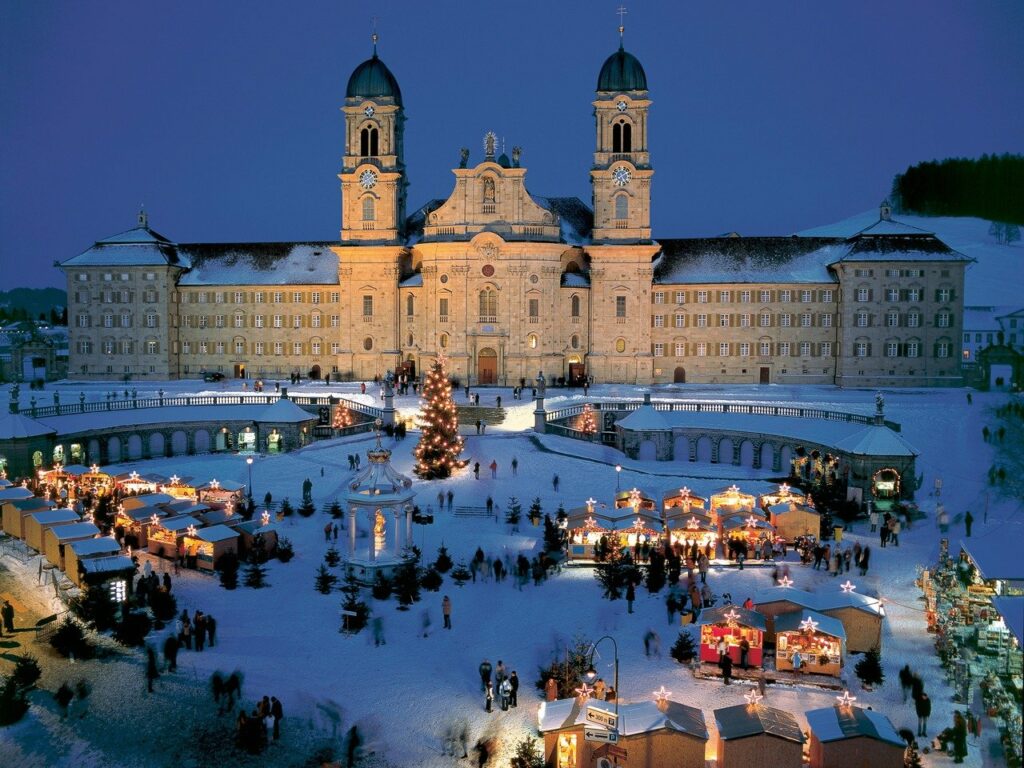
The Christmas market in front of Einsiedeln Abbey in canton Schwyz is a particularly picturesque one (Credit: Zurich Tourism).
However you celebrate the holiday season, we hope you can spend precious time with those you love. Maybe this year, try one of these Swiss traditions with your family or friends. We wish you a lovely holiday season. Frohi Weihnachten! Joyeux Noël! Buon Natale!
Dieser Artikel darf frei weitergegeben und nachgedruckt werden, vorausgesetzt, es wird auf den Originalartikel verwiesen.
